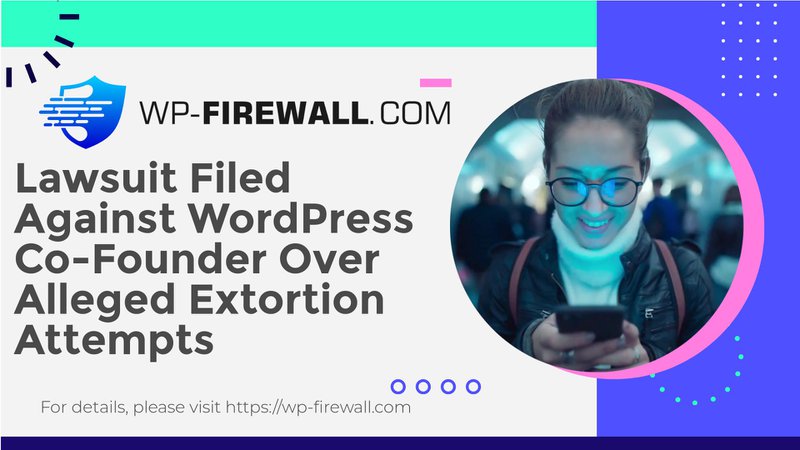
WordPress-Mitbegründer und Automattic wegen versuchter Erpressung verklagt: Eine Sicherheitsperspektive
Die jüngste Klage von WP Engine gegen den WordPress-Mitbegründer Matt Mullenweg und Automattic hat eine hitzige Debatte innerhalb der WordPress-Community ausgelöst. In diesem Rechtsstreit geht es nicht nur um Markenrechtsverletzungen, sondern auch um Vorwürfe von Machtmissbrauch, Erpressung und Gier. Aus Sicherheitsperspektive unterstreicht dieser Fall, wie wichtig es ist, Vertrauen und Transparenz im Open-Source-Ökosystem aufrechtzuerhalten.
Hintergrund des Streits
Der Streit zwischen WP Engine und Automattic begann, als Matt Mullenweg begann, WP Engine wegen angeblicher Verletzung der Markenrechte von WordPress und WooCommerce zu kritisieren. Mullenweg bezeichnete WP Engine als „Krebsgeschwür von WordPress“ und meinte, dass ihre Handlungen der Community schaden würden. Dieser öffentliche Streit eskalierte, als WP Engine eine Unterlassungsaufforderung an Automattic schickte und sie aufforderte, diese Kommentare zurückzuziehen.
Wesentliche Vorwürfe in der Klage
- Machtmissbrauch und Erpressung:WP Engine wirft Mullenweg und Automattic vor, ihre Macht zu missbrauchen, um Geld von ihnen zu erpressen. Konkret behaupten sie, dass Automattic eine Lizenzgebühr von 8% aus den monatlichen Einnahmen von WP Engine für die Verwendung der Marken WordPress und WooCommerce verlangt habe. Diese Forderung wurde ohne vorherige Warnung gestellt und beinhaltete eine Probezeit für das Forken von Plugins und Erweiterungen von Automattic und WooCommerce.
- Markenrechtsverletzung:Die Klage behauptet, dass die Verwendung der Marke WordPress durch WP Engine im Rahmen des Fair Use legal ist. Automattic behauptet jedoch, dass die Handlungen von WP Engine eine Markenrechtsverletzung darstellen, die zu erheblichen finanziellen Verlusten für Automattic geführt hat.
- Falsche Angaben und IRS-Betrug:WP Engine wirft Mullenweg vor, gegenüber dem IRS falsche Angaben zur Übertragung der WordPress-Marke von Automattic an die gemeinnützige WordPress Foundation und zurück an Automattic durch eine exklusive unterlizenzierbare Lizenz gemacht zu haben. Dies wird als Verstoß gegen die IRS-Vorschriften und als Versuch angesehen, die Kontrolle von Automattic über die Marke zu verschleiern.
- Amtsmissbrauch und gebrochene Versprechen:Die Klage behauptet, dass Automattic seine Versprechen, WordPress-Open-Source-Projekte ohne Einschränkungen zu betreiben, nicht eingehalten hat. Stattdessen wird behauptet, dass Automattic in den Betrieb von WP Engine eingegriffen hat, indem es ihnen den Zugriff auf bestimmte Ressourcen wie Plug-Ins und Themes untersagt hat, was dem Geschäft von WP Engine und dem breiteren WordPress-Ökosystem geschadet hat.
Auswirkungen auf die Sicherheit
- Vertrauen und Transparenz:Der Open-Source-Charakter von WordPress beruht in hohem Maße auf dem Vertrauen innerhalb der Community. Die Vorwürfe des Machtmissbrauchs und der Erpressung gefährden dieses Vertrauen, indem sie suggerieren, dass Schlüsselfiguren der Community in ihrem eigenen Interesse und nicht zum Wohle aller Benutzer handeln.
- Auswirkungen auf das Ökosystem:Der Streit zwischen WP Engine und Automattic hat weitreichende Folgen für das gesamte WordPress-Ökosystem. Er zeigt, wie Konflikte zwischen großen Akteuren den normalen Betrieb von Websites stören und nicht nur ein Unternehmen, sondern viele andere, die auf WordPress angewiesen sind, beeinträchtigen können.
- Gemeinschaftsverwaltung:Die Klage wirft Fragen zur Governance innerhalb der WordPress-Community auf. Sie behauptet, dass Matt Mullenweg die WordPress Foundation aus eigenen kommerziellen Interessen kontrolliert, was den gemeinnützigen Status der Organisation und ihr Engagement für Offenheit und Freiheit untergraben könnte.
Abschluss
Die von WP Engine gegen Matt Mullenweg und Automattic eingereichte Klage ist ein komplexes Verfahren, das Vorwürfe von Machtmissbrauch, Erpressung, Markenrechtsverletzung und Amtsmissbrauch beinhaltet. Aus Sicherheitsperspektive unterstreicht sie, wie wichtig es ist, das Vertrauen innerhalb einer Open-Source-Community aufrechtzuerhalten. Die Gewährleistung von Transparenz in der Verwaltung und die Einhaltung ethischer Standards sind für die Wahrung der Integrität solcher Ökosysteme von entscheidender Bedeutung.
Schützen Sie Ihre WordPress-Site vor ähnlichen Bedrohungen
So schützen Sie Ihre WordPress-Site vor potenziellen Bedrohungen wie den in diesem Fall beschriebenen:
- Aktualisieren Sie Plugins und Themes regelmäßig:Indem Sie Ihre Site mit den neuesten Plug-Ins und Designs auf dem neuesten Stand halten, können Sie Schwachstellen vermeiden, die von böswilligen Akteuren ausgenutzt werden könnten.
- Verwenden Sie sichere Passwörter und eine Zwei-Faktor-Authentifizierung:Durch die Implementierung robuster Sicherheitsmaßnahmen wie sicherer Passwörter und Zwei-Faktor-Authentifizierung kann das Risiko eines unbefugten Zugriffs erheblich verringert werden.
- Überwachen Sie Ihre Site auf böswillige Aktivitäten:Durch regelmäßiges Überwachen Ihrer Site auf verdächtige Aktivitäten können Sie potenzielle Bedrohungen schnell erkennen und darauf reagieren.
- Verwenden Sie ein zuverlässiges Sicherheits-Plugin:Die Verwendung eines bewährten Sicherheits-Plugins kann zusätzlichen Schutz gegen gängige Angriffe aus dem Internet bieten.
Durch Befolgen dieser bewährten Methoden können Sie dazu beitragen, dass Ihre WordPress-Site sicher und widerstandsfähig gegenüber potenziellen Bedrohungen bleibt.
Warum Sie WP-Firewall brauchen
Angesichts dieses anhaltenden Streits ist es klar, dass die Aufrechterhaltung robuster Sicherheitsmaßnahmen für jede WordPress-Site von entscheidender Bedeutung ist. WP-Firewall bietet erweiterte Sicherheitsfunktionen, die Ihre Site vor verschiedenen Bedrohungen schützen sollen, darunter:
- Bedrohungserkennung in Echtzeit:WP-Firewall überwacht Ihre Site kontinuierlich auf verdächtige Aktivitäten und warnt Sie in Echtzeit vor potenziellen Bedrohungen.
- Erweiterte Malware-Scans:Das Plugin enthält erweiterte Malware-Scanfunktionen, die Schadcode auf Ihrer Site erkennen und entfernen können.
- IP-Blockierung:Sie können als bösartig gekennzeichnete IP-Adressen blockieren und so weitere Angriffe verhindern.
- Verbesserungen bei der Anmeldesicherheit:WP-Firewall umfasst Funktionen wie Zwei-Faktor-Authentifizierung und die Durchsetzung starker Passwörter zur Verbesserung der Anmeldesicherheit.
- Regelmäßige Updates und Support:Das Plugin erhält regelmäßige Updates und Support von seinen Entwicklern, sodass sichergestellt ist, dass Sie Zugriff auf die neuesten Sicherheitspatches und Funktionen haben.
Durch den Einsatz von WP-Firewall können Sie die Sicherheit Ihrer WordPress-Site erheblich erhöhen und sie vor potenziellen Bedrohungen wie den in diesem Fall beschriebenen schützen.
Schützen Sie Ihre Site mit uns
Um Ihre WordPress-Site vor potenziellen Bedrohungen zu schützen und ihre Sicherheit zu gewährleisten, sollten Sie noch heute WP-Firewall herunterladen. Mit seinen erweiterten Funktionen und der Bedrohungserkennung in Echtzeit ist WP-Firewall die perfekte Lösung zum Schutz Ihrer Online-Präsenz. Melden Sie sich für den kostenlosen Plan von WP-Firewall an über https://my.wp-firewall.com/buy/wp-firewall-free-plan/ um loszulegen.

